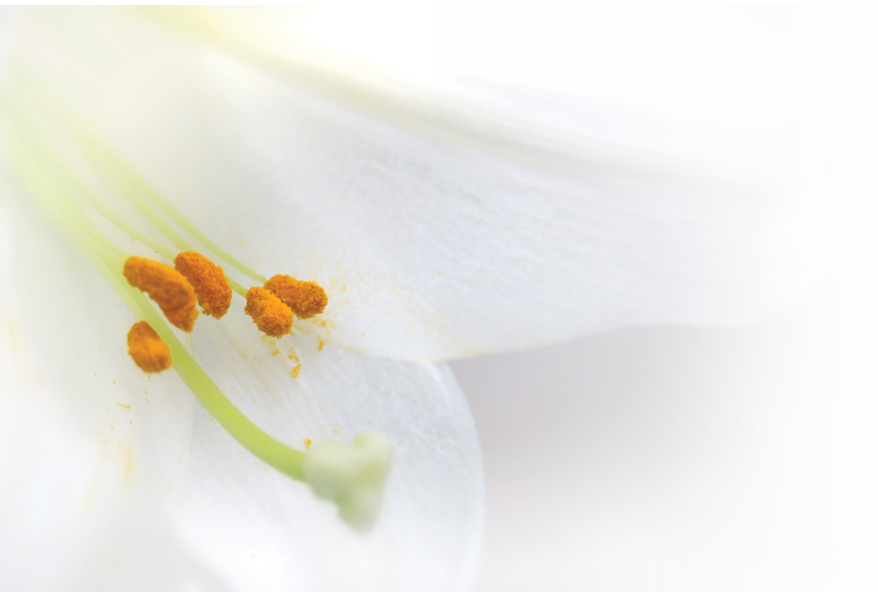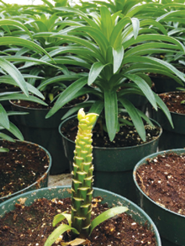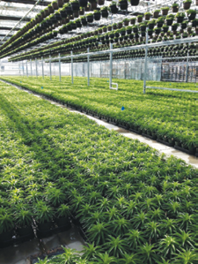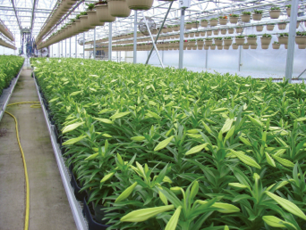
Editor’s note: This article is part II of a two-part series of Easter lily production tips. For more about timing, vernalization and a detailed schedule organized by week number and dates, look back to the September 2016 issue or go to bit.ly/2chbSfe
Begin greenhouse forcing as soon as the 6 weeks of bulb cooling is complete, but make sure you start no later than week 17 for case-cooled bulbs or week 14 for pot-cooled bulbs. Handle and pot case-cooled bulbs as previously described and immediately move them into the 60-62°F greenhouse.
Lilies begin emerging from 1-3 weeks after forcing begins, so record the emergence date (you will need it later for leaf counting) and, based on time of emergence, separate lilies into early, mid and late groups. Bud initiation starts immediately after emergence. You can increase bud set at this time by dropping the greenhouse forcing temperature for 7-14 days following primary bud initiation. The cool temperatures have the added benefit of slowing greenhouse forcing. Only use this technique if you start greenhouse forcing of case-cooled lilies 18-19 weeks before Easter rather than the normal 17 weeks, or pot-cooled lilies 15-16 weeks before Easter rather than the normal 14 weeks. Run 60-62oF until primary buds initiate.
Once primary buds are set, lower the greenhouse temperature to 46°F for up to 14 days to stimulate secondary bud formation. After this period, raise the temperature to 60-62°F until bud initiation is complete (mid- to late January). If greenhouse forcing started just one week ahead of schedule, limit the duration of the cool period to 7-10 days.
The cool temperature treatment must start with primary bud initiation, which, as a rule of thumb, coincides with initial stem root development. When the roots just begin to break out of the stem (? inch), that is a sign that bud initiation is starting. You must determine when primary bud initiation occurs to achieve the desired effect. Timing is critical, since flower bud initiation may be adversely affected or delayed by temperatures that are lowered before bud initiation starts. In contrast, temperatures lowered after bud initiation is complete will have no beneficial effect on bud count, but will slow overall crop development.
Start leaf counting after bud set is complete and use temperature to control the rate of lily development during the remainder of the greenhouse forcing schedule. The rates of both leaf and flower development can be adjusted with temperature. For example, at 72°F, leaves unfold at a rate of 2 per day on average, while at 63°F the rate decreases to 1.5 leaves per day. Likewise, a lily will go from visible bud to bloom in 24 days at 81°F, 31 days at 70°F, 35 days at 64°F and 42 days at 59°F. If you arrive at visible bud 5 to 7 weeks before Easter and you can control temperature within these limits, you should be in good shape to finish on time. Finally, plants that bloom early can be held in a cooler for up to two weeks. Storing finished lilies for longer than two weeks in not recommended.
Leaf counting
As a reminder, the leaf counting technique is based on the fact that once flower buds initiate, leaf number is set and will not change. However, the exact number of leaves varies from year to year, and also with bulbs from different sources or bulbs exposed to different vernalization (bulb cooling) conditions.

You already recorded the average date of emergence for the early, mid and late groups of lilies in your crop. Also record the average daily greenhouse temperature following shoot emergence. After bud initiation, select 5 lilies for every 1,000 plants in each group (e.g. lilies grouped by bulb source, emergence time, etc.). Select plants representative of the overall crop, and then remove, count and record the total number of leaves. Use magnification and a needle to remove and count the smallest, un-expanded leaves. (Note: The shoot tip should show evidence of tiny flower bud formation. If this is not the case, you started counting too early. Wait one week and try again.) Record the number of fully developed leaves (those at a 45-degree angle to the stem or greater) and the number of undeveloped leaves (those at an angle less than 45 degrees to the stem). Now, divide the number of fully developed leaves by the number of days since shoot emergence. This is the “current rate of leaf development.” Divide the number of undeveloped leaves by the number of days remaining until visible bud. This is the “required rate of leaf development” or the rate you need to maintain as you move forward in the schedule.
If the “current rate of development” is too fast, indicating the crop will reach visible bud early, reduce the temperature in the greenhouse. If the “current rate of development” is too slow, indicating the crop will reach visible bud late, increase the average greenhouse temperature to speed development.
Determine a new current rate each week (the rate since last count) and a new required rate. Determine the new required rate by subtraction — you do not have to destroy any more plants. Simply subtract the number of fully developed leaves from the average total number of leaves previously determined. Tip: Use a string tied around the stem, mark a leaf with a marking pen, or use a paper punch to mark the last leaf counted as fully developed on your indicator plants.
Height control
Stem stretch tends to increase with low-light, warm temperatures and long days. Expect long daylengths and warm temperatures in late-March and April. Crowding lilies or shading lilies with overhead baskets will increase the tendency for stretch.

Growth regulators should not be applied until after flower buds have set and if you are running constant day/night temperatures at this stage as recommended, the zero DIF effect should be adequate to control stretch. Unless used at very low concentrations, early growth regulator applications can reduce bud count. The DIF effect can be achieved with equal day/night temperatures, high night/low day temperatures or by dropping greenhouse temperature below the night-time set point for the first 2 hours at sunrise.
To control lily height, begin applying PGRs (A-Rest, Chlormequat E-Pro, Concise, Cycocel, Topflor or Sumagic) as needed when shoots are 3-5 inches tall. Split applications provide the best results. You can apply any of the PGRs at ? to ½ normal rate, as needed, to control height.
Pest and disease management
Aphids, fungus gnats and bulb mites are a major concern on lilies. Many chemicals are listed for aphid control, including Safari, Flagship, Tristar, Marathon and many generics, DuraGuard, Enstar AQ, Suffoil X, Insecticidal Soap, M- Pede, Kontos, Endeavor, Aria, Mainspring GNL, and Rycar. Fungus gnats can be controlled with some of these same chemicals as well as Citation, Distance, Adept, Pylon, insect parasitic nematodes (Nemasys, NemaShield, Scanmask, Entonem) and Gnatrol WDG. Bulb mites, Rhizoglyphus robini, represent one of the more troublesome insect pests on lilies and effective management requires an integrated approach. Bulb mites are considered a secondary pest and are commonly associated with decay caused by fungus gnat damage and soilborne fungal pathogens. The soil dwelling predatory mite, Hypoaspis aculeifer, may help suppress bulb mites. Note: Registration of pesticides varies by state so consult and follow labels for registered use. To avoid any potential phytotoxicity or residue problems, spot test before widespread use. No discrimination is intended for any products not listed.
Disease and pest control
Before planting, clean bulbs of debris removing any scales showing evidence of infection or physical damage.
Once potted, root rots associated with Rhizoctonia, Fusarium and Pythium are a concern. Drench immediately with Banrot, Pageant Intrinsic or Empress Intrinsic, broad-spectrum fungicides, or you can treat to control these diseases separately by selecting from the fungicides specifically registered for Rhizoctonia, Fusarium and Pythium control on lily. Materials registered for Rhizoctonia and/or Fusarium include Cleary’s 3336, OHP 6672 26GT, 26/36 and many generics such as Pageant Intrinsic and Contrast (Rhizoctonia) and Terraclor (Rhizoctonia). Materials registered for controlling Pythium include Alude, Banol, Subdue Maxx (Beware of using mefenoxam exclusively because of widespread fungicide resistance issues with this active ingredient), Segway O, and Truban. Check with manufacturers regarding compatibility when tank mixing fungicides. Fungicides may need to be re-applied later in the crop. Check labels for guidance. Preventative biological fungicides (RootShield, Rootshield Plus, CEASE, Actinovate, Mycostop, Companion and Triathlon BA) may be applied at planting for disease suppression and to enhance root growth. Check with company or product labels information for safe time intervals between application of biological agents and chemical fungicides.
Prevent leaf yellowing
Monitor lilies for lower leaf yellowing, beginning one to two weeks before visible bud. Lower leaf yellowing often begins about the time buds first appear and becomes progressively worse over time. Apply Fascination or Fresco during greenhouse forcing if leaf yellowing is evident or has been a problem in the past. To prevent early-season leaf yellowing (7-10 days before visible bud) and mid-season leaf yellowing (7-10 days after visible bud), spray Fascination (Fresco) at 5/5 to 10/10 ppm. Apply only to lower leaves and cover thoroughly.

Prolonged cold storage prior to shipping and poor shipping conditions can also favor sudden, catastrophic yellowing. Plants that bloom early can be held in a cooler for up to 2 weeks, but I recommend an application of Fascination or Fresco on lilies held in cold storage for more than 7 days. Spray 100/100 ppm over the top of the plant when buds are about 3 inches long, but no more than 14 days prior to cold storage or shipping. Fascination and Fresco contains two active ingredients and recommended concentrations refer to both active ingredients. For example, a 100/100 ppm spray will contain 100 ppm BA plus 100 ppm GA4+7.]
It is also prudent to spray for botrytis control prior to moving lilies to cold storage. Fungicides labeled for botrytis control include Veranda O, Phyton 27 and the biofungicide CEASE. Always follow label directions and test fungicides on a small group of lilies for damage to or residue on lily buds before using on the entire crop.
Water Easter lilies thoroughly before starting cold storage. After removing from the cooler, place lilies in a shady location to avoid excessive wilting.
Post-harvest flower life
EthylBloc can be used to extend lily flower life. EthylBloc is a plant growth regulator that is used to prevent early flower death caused by ethylene. Apply EthylBloc to plants with open or mature buds just prior to shipping.
After the sprint-to-the-finish we had last year, the 2017 schedule should be a joy. You have plenty of time to pay attention to detail and bring the crop in right. Remember, to produce the best quality crop possible, stay on schedule and use preventive measures to check disease and insect problems early. Good luck in 2017.

Explore the October 2016 Issue
Check out more from this issue and find you next story to read.
Latest from Greenhouse Management
- CIOPORA appoints Micaela Filippo as vice secretary-general
- Passion grows progress
- Registration opens for Darwin Perennials Day
- U.S. Department of Labor finalizes farmworker protection rule
- Azo Root is now available from Harrell’s
- Bidens ferulifolia Blazing Glory
- Rob Hanifin joins Ridder North America as product specialist for climate screens
- The importance of measuring light





